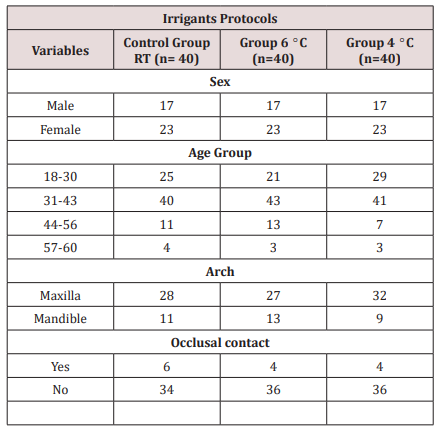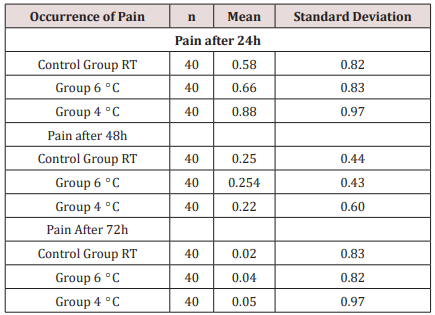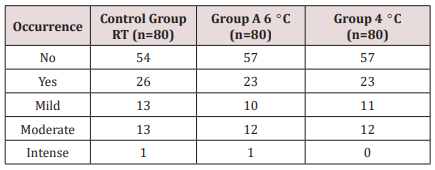Lupine Publishers | Journal of Otolaryngology Research Impact Factor
Abstract
Objective: The purpose of this research was to evaluate whether meticulous irrigation with three different temperatures would
help in a decrease dental pain.
Materials and Methods: All 120 patients had teeth
chosen for conventional RCT for prosthetic reasons in teeth with vital
pulps.
All canals were cleaned and shaped with Reciprocal files.
Final irrigation was done with cold saline solution (6 OC, 4 OC, and
room
temperature).
Results: A total of 120 of 135 patients (69 females
and 51 male) were included whereas 15 were excluded as not achieving
the necessities of the study. All patients presented with a
vital upper or lower molar, premolar, or front teeth. No statistically
major
change (P>0.05) between the groups was found regarding the
degree or duration of pain.
Conclusion: The approach in both selecting the
patients participating in the research and analyzing the data in this
research
allows us to determine that cryotherapy is an aid of clinical
procedures to clean and shape the canals to decrease the occurrence of
post-endodontic pain and the need for medication in patients
presenting with a diagnosis of vital pulp.
Keywords: Apical healing; Flare-ups; Pain; Post endodontic pain; Post-operative pain
Introduction
Post-endodontic pain is an undesirable sensation occurred in
patients regardless of the preoperative periapical status of the tooth
treated. Therefore, prevention and management of post endodontic pain
are essential in endodontic practice [1]. Organic material,
microorganisms, and irrigating solutions extruding beyond the apical
constriction during root canal therapy (RCT) will originate inflammation
and periodontal ligament complications, such as severe pain or
flare-ups. It must be noticed that the amount of extruded material
(debris and/or irrigate) varies widely in the reported studies which
indicate problems and inconsistencies in treatment methodologies [2-4].
Recent literature has showed that keeping apical patency would not
generate more postoperative difficulties [5-7]. A recently issued in
vitro study showed that intracanal delivery of cold irrigating solution
at 2.5 °C with negative pressure flushing reduced the external surface
temperature to close 10 °C [8-10], would be enough to create a local
anti-inflammatory beneficial consequence in peri radicular tissues.
Cryotherapy proposes that using cold over some procedures may decrease
the diffusion of nerve signs, bleeding, edema, and local inflammation
and is therefore effective in the reducing of pain. Therefore, the
purpose of this research was to evaluate whether meticulous irrigation
with three irrigating practices with different temperature would help in
a decrease of post-endodontic pain.
Three expert endodontists with a private practice of 17 years
and skilled in the procedures and procedures studied were included in
the research and performed 40 RCTs each (a total of 120) in upper/lower
front or back teeth with irreversible pulpitis recognized by pulp
sensitivity testing with hot and cold. Pulpal response tests were
achieved by the main author, and a digital X ray diagnosis was
documented by three certified clinicians. Additional clinical
necessities for patients´ inclusion were as follows: Necessities of the
research were agreed and spontaneously accepted, healthy patients were
included, teeth with enough coronal structure and diagnosed with vital
pulps, no previous RCT, and no analgesics or antibiotic consumption 7
days before the procedures. A total of 120 of 135 patients (69 females
and 51 male) aged 18 – 60 years were referred and integrated in this
research, whereas 15 were rejected as not accomplishing the necessities
wanted. All participants showed with a vital upper or lower molar,
premolar or front teeth designated for conventional RCT for dental
rehabilitation reasons.
Methods
Dental procedures
Root canal treatment was done in one visit. Topical
anesthetic (Anesthesia Topical, Astra, Mexico) was used. Patients
received 2 carpules of articaine 2% with epinephrine 1:200,000
(Septodont, Saint-Maur des-Fosses, France). Situations in which
supplementary anesthesia was needed, intra-ligamental anesthesia (2mL
articaine 2%) was supplied. For the upper front teeth, the solution was
administered by tender and slow local infiltration. For the lower teeth,
one of the carpules was used for the lingual and alveolar nerve block,
the other one for a moderate bucal infiltration nearby the tooth to be
treated.
Irrigation protocols
Group 6 °C. The R25 (size 25/ .08) instrument was employed in
tinny and curved canals, and R40 files (40/ .06) were used in broad
root canals. Three in-and-out pecking series were employed with a
fullness of not more than 3mm until getting the calculated WL. Patients
allocated to this group receive a final irrigation with 5mL of cold (6
°C) 17% EDTA followed by 10mL of cold (6 °C) sterile saline solution
dispensed to the WL using a cold (6 °C) metallic micro-cannula.
Group 4: Canals were instrumented as in group A. Patients
allocated to this set received a final irrigation with 5mL of cold (4
°C) 17% EDTA followed by 10mL of cold (4°C) sterile saline solution
dispensed to the WL using a cold (4 °C) metallic micro-cannula for 1
minute.
Group RT: The R25 (size 25/ .08) instrument was employed in
tinny and curved root canals, and R40 files (40/ .06) were used in wide
canals. Three in-and-out series were employed with a space of not more
than 3mm until getting the calculated WL. Reciprocal instruments were
used in one tooth only (single use). Participants allocated to this
control group were treated similarly to the experimental groups, except
that they received a final flush with 5mL (room temperature) of 17% EDTA
followed by 10 mL (room temperature) of sterile saline solution
delivered to the WL.
Statistical analysis
The related issues preoperatively recorded were integrated into
the examination as follows: age and sex, occlusal contacts, and maxilla
or mandibular teeth. Changes in the strength of pain among groups were
studied using the ordinal (linear) X2 test. Variances in VAS-recorded
standards after 24, 48, and 72 hours and in the quantity of analgesic
intake among the two groups tested.
Results
Table 1 displays the distribution of variables; a total of 120
participants took part in this study: 69 (57.5%) were women, and 51
(42.5%) were men. The ages fluctuated among 18 and 60 years; 87 (72.5%)
were upper teeth, and 33 (27.5%) were lower teeth. The clinical
management of the patients is showed in Table 1. No significant
modification (P > 0.05) between the groups was encountered concerning
the grade or period of pain. Rendering to the VAS examination, marks
were seen 24 – 72 hours late in the 3 groups with a significant decline
successively (Tables 2 & 3).
Discussion
Pain is tough to comprehend and calculate especially when it
occurs unexpectedly in patients. The major trouble in knowledge painful
and discomfort is the participant’s individual valuation and its
dimension. For this objective, organization of the estimation form has
to be entirely understood by participants. In our research, a simple
spoken classification was followed in the feedback procedure with four
classes: no pain, slight, modest, and intense pain. These classes were
clearly comprehended by participants and were described by the
occurrence or nonappearance of the necessity for pain-relieving
treatment. Preoperative pain is one of the main predictors of
post-endodontic pain [11-14]. Thus, only teeth with irreversible
pulpitis indicated for RCT because of prosthodontic purposes were
treated in this research. In our research, we reduced the variation in
the procedures following protocols based on recommendations by authors
and manufacturers. While successful endodontic treatment depends on
various variables, an important point to consider in the shaping of the
root canal system is the amount of the irrigating solution. Proper
disinfecting and filling the root canal system is facilitated by the
keeping of its original shape from the entrance to the apical third,
without any iatrogenic event.
Conclusion
According to the conditions established for this study, there
was no statistically significant difference between the instrumentation
systems assessed.
Read More Lupine Publishers Journal of Otolaryngology Articles :
https://lupine-publishers-otolaryngology.blogspot.com/
https://lupine-publishers-otolaryngology.blogspot.com/
Read More Lupine Publishers blogger Articles : https://lupinepublishers.blogspot.com




No comments:
Post a Comment
Note: only a member of this blog may post a comment.